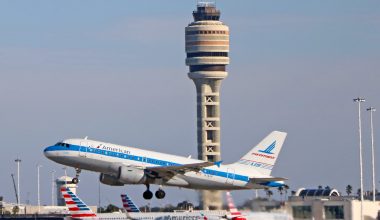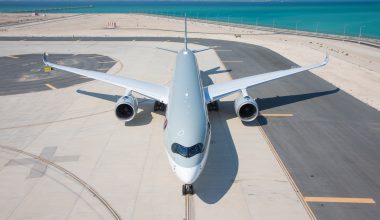If there is one aircraft that spawned love-hate relationships over the period it flew, it has to be an MD80 plane. The McDonnell Douglas MD80 was the aircraft hated and loved in nearly equal measure by pilots and passengers alike. The single-aisle plane was sturdy and durable but had nothing cutting-edge regarding customer experience. Passengers flying in the front of the aircraft could enjoy a tranquil ride while it was the opposite experience on the rear. The plane’s un-ergonomic cockpit wasn’t equipped with computers and was challenging to fly. On the positive side, the hands-on affair gave pilots more control over every aspect of the plane and sharpened their skills.
For four decades, the twin-engine McDonnell Douglas MD80 plane has had a longstanding love/hate relationship with the flight crew and passengers.

Introduction to McDonnell Douglas MD-80
MD-80 is a series of five-abreast, single-aisle, twin-engine airliners developed from the McDonnell Douglas DC-9. It is a modernized and stretched derivative of the original DC-9 that entered commercial service on October 10, 1980. Developed as the second generation of the DC-9 family, the MD-80 series was a lengthened version of the Series 50 with a larger wing and a higher MTOW. It was an improved aircraft design with a stretched & enlarged wing, higher fuel capacity, and more efficient JT8D turbofan engines than its forerunner.
Also Read: How many McDonnell Douglas DC-10 ‘s are still flying ?
The developer company initially designated MD-80 as the DC-9-80 (DC-9 Series 80) and launched the aircraft program in October 1977. The elongated derivative flew for the first time in October 1979 as ‘the Super 80’ and bore the official designation MD-80 in July 1983.
Design of the MD80 plane
MD80 plane is a five-abreast single-aisle plane fitted with higher bypass Pratt & Whitney JT8D-200 engines. Based on the DC-9 Series 55 aircraft, MD-80 is a new aircraft with a longer body, a large wing design, an updated flight deck, and more fuel-efficient engines. The fuselage is stretched by 14 feet 3 inches (4.34m) from the DC-9-50, allowing the airliner to carry a couple more passengers than its predecessor.
The mid-size, medium-range MD-80 has two turbofan engines mounted on the rear of the fuselage and a T-tail empennage configuration. The old-school design and noise produced two engines in front of the tail made the MD80 plane easily recognizable.
Apart from more powerful engines (compared to earlier counterparts), the aircraft also incorporated advanced avionics and a multi-panel electronic flight instrument system. Although the aircraft’s design wasn’t necessarily ground-breaking, it was a definite step up from its predecessor, the DC-9.
Performance of MD-80
The two Pratt &Whitney JT8-200 high-bypass turbofans work in tandem to enable the MD-80 plane to fly as far as 2,897km. The narrowbody aircraft has a cruise speed of 811km/hour and can reach a maximum speed of 925km/hr. Measuring 147 ft 10 inches long, the MD80 plane can comfortably seat 155 passengers in a typical single-class configuration. Moreover, it can accommodate 172 passengers in a high-density layout for budget carriers. The two-class setup (business class + economy class) slightly reduces the seating capacity to 143 passengers.

The twin-engine MD80 plane once provided the backbone of top US carriers like American Airlines, Delta, Trans World Airlines, etc. It was a promising fit for airlines offering flights between smaller cities and their large hubs.
The rear-engined MD-80 airliner revolutionized short-haul travel in its own right in the US. Its maximum fuel range of 2,871 miles made it a solid choice in the regional and short-to-medium-haul market segment. Thanks to its design, the MD80 plane could use a wide range of airports, from short-runway to larger ones.
Variants of the MD80 plane
Across two decades of production, McDonnell Douglas offered five different MD-80 variants for various purposes. The diverse MD-80 series aircraft includes the following five versions:
MD-81: The first production model that made its first flight on October 18, 1979, and entered service with Swissair on September 13, 1980.
MD-82: Equipped with more powerful engines, the MD-82 made its inaugural flight on January 8, 1981. The new MD-80 variant was designed to serve hot and high airports. It bore similar dimensions to the original production version except for more efficient engines.
Also Read: United Airlines to get additional 100 Boeing 737 MAX 8 aircraft
MD-83: The long-range version of the basic MD-81/82 fitted with slightly more powerful JT8D-219 engines. Additional upgrades include increased fuel capacity, strengthened landing gears, higher weights, etc.
MD-87 is a shorter-fuselage MD-10 variant employing the same engines, systems, and flight deck as other MD-80s. It is 17 feet 4 inches shorter than other long-body MD-80 variants and offers typical dual-class seating for 114 passengers.
MD-88: The last MD-80 variant has similar specifications as MD-82 or MD-83 but with a modern cockpit featuring EFIS displays. The MD-88 project received a go-ahead in January 1986, and the first MD-88 flight took place on August 15, 1987.
Why did pilots love/hate the MD80 plane?
The pilots had mixed feelings and varying opinions regarding MD-80 planes. While some pilots considered the MD-80 a decent aircraft to fly, few didn’t have positive opinions about flying the MD-80. Some of the aspects pilots loved about the MD-80 plane were:
Unique handling characteristics: The unique flight handling characteristics of the MD-80 plane required pilots to input data manually instead of relying on onboard computers. This gave pilots a sense of pride in retaining more control over every aspect of the aircraft.
Advanced aerodynamics: The McDonnell Douglas MD80 incorporated more advanced aerodynamics and an avionics suite
than its earlier counterparts.
Reliability: The twin-engined MD-80 was a reliable workhorse built like a flying tank. The sturdy and strong narrowbody airliner worked well in short-haul and medium-haul operations.
The pilots who accepted the challenge of operating MD-80 planes honed their airmanship skills. The MD-80 airliner was difficult to fly, but it sharpened the pilots’ skills and forced them to think critically.
Now, let’s take a quick look at why pilots disagreed about flying the McDonnell Douglas MD80.
Cockpit ergonomics: The cockpit design and layout were un-ergonomic, outdated, and less user-friendly for some pilots. There was no central window post; the switches and dials were fitted randomly, and instrumental panels weren’t as intuitive as other aircraft.
Lack of advanced technology: The outmoded and old-fashioned avionics and systems made the MD-80 less appealing to pilots.
Control inputs: Some pilots had reservations about MD-80 as they felt the twin jet responded slowly to their control inputs.
Significance of MD-80 for American Airlines
Dallas-based American Airlines is the largest former operator of MD80, with whopping 391 units operated across its history on a different timeframe. The carrier relied on its MD80 workhorse to fortify its expansion through the end of the 20th century on its crucial routes. The MD-80s solidified AA’s hub-and-spoke operations by connecting smaller cities and massive hub airports. These planes served AA’s bread-and-butter routes and handled most of the carrier’s flight operations. The Texas giant offered several thousands of
As time passed and aircraft design technology advanced, airlines started dumping MD-80s in favor of new jets. With better alternatives emerging, carriers moved to new versions of jet families with better fuel efficiency, additional seats, and the newest technology. The mega US carrier AA took its MD80 fleet to the grave in September 2019. It purchased new-generation, fuel-efficient aircraft like Boeing 737 and Airbus A320 family jets to serve its bread and butter routes.
Fall of the MD80 plane
While the McDonnell Douglas MD80 plane was successful and influential, it was ultimately supplanted. Over time, the single-aisle MD-80 series jets grew progressively unsatisfactory for US carriers’ passenger transport needs. The cockpit was un-ergonomic; the interior lacked the coolest passenger service systems and touches, and the engines were noisy. The McDonnell Douglas Company pulled the curtain down on the MD-80 series aircraft after 20 years of production in 1999. The company built 1,191 MD80 units across its two-decades-long production cycle between 1979 and 1999.

The twin-engine MD-80 airliner is the forerunner to IAE V2500-turbofan-powered McDonnell Douglas MD-90. The succeeding MD-90 aircraft is a stretched derivative of the earlier-built MD-80 with a 5ft (1.4m) longer fuselage.
MD-80 status: Are there any MD-80s still flying?
Although the production of the MD-80 plane ended years long ago, the airliner remains relatively widespread even today. The widely-produced rear-engined MD-80s still have over 60 active examples serving various carriers today. Many active MD-80s are performing the role of a cargo airliner, ferrying goods, and mail on behalf of cargo airlines. As aircraft get older, it’s common for airlines to convert them for use as freighters. The all-cargo realm has helped extend the useful life of these aging birds.
The current prominent operators of the McDonnell Douglas MD-80 aircraft are:
- Mexico-based Aeronaves TSM
- Iran-based Zagros Airlines
- Venezuela-based LASER Airlines
- Iran-based ATA Airlines
- US-based World Atlantic Airlines
- Bulgaria-based European Air Charter
- USA Jet Airlines, etc.






